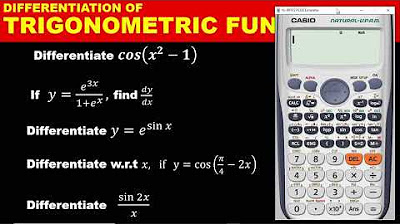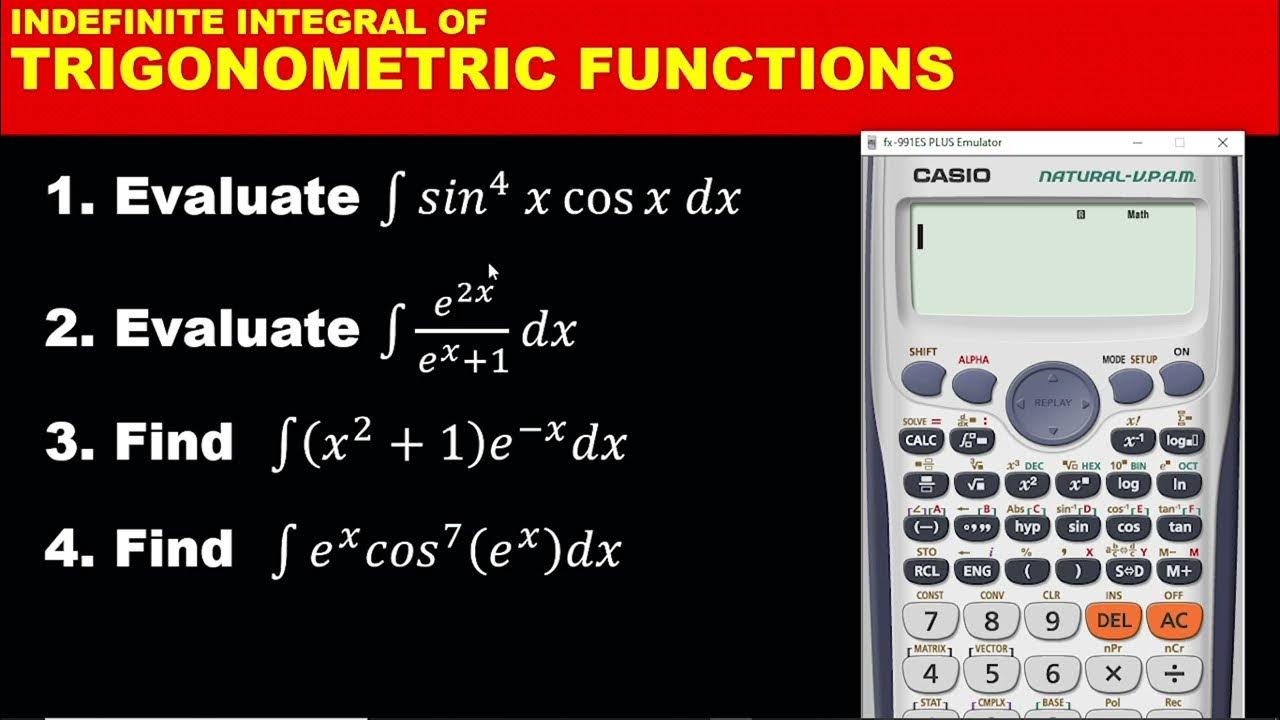Trigonometry Calculator Techniques by Engr. Yu Jei Abat | #AbatAndChill
TLDRThis instructional video script focuses on solving trigonometric functions using calculator techniques, part of an ongoing series on the YouTube channel. The script guides viewers through evaluating expressions involving sin, cos, tan, and their multiples, utilizing substitution with a calculator set to degree mode. It simplifies expressions and approximates answers by comparing values to choices, demonstrating the process for five example problems. The script concludes with a reminder to like, share, and subscribe for more educational content.
Takeaways
- 📚 The video is part of a series on calculator techniques for solving trigonometric functions, aimed at helping viewers understand how to use their calculators effectively.
- 🔍 The presenter suggests subscribing to their YouTube channel for more content on calculator techniques, indicating the video is part of an ongoing educational series.
- 📈 In the first problem, the process involves evaluating a trigonometric expression by substituting x with 5 degrees and using the calculator to find the value of the expression.
- 📝 The video demonstrates how to use the calculator's memory function to store and compare values for checking answers against multiple-choice options.
- 🔑 The simplification of the first problem results in the expression 'tangent of 2x', highlighting the importance of recognizing and applying trigonometric identities.
- 📐 For the second problem, the presenter uses the variable 'y' and the calculator to simplify an expression involving sine and cosine, emphasizing consistency in variable usage.
- 🔍 The process involves careful input of trigonometric functions into the calculator, such as 'sin squared of Y', and comparing results with multiple-choice answers.
- 🎯 The correct answer for the second problem is identified as 'sine of 4y', which matches the stored value, demonstrating the methodical approach to solving trigonometric simplification.
- 🔢 In the third problem, the presenter evaluates an expression involving tangent and uses the calculator to approximate the value, comparing it with multiple-choice options to find the closest match.
- 📉 The video explains the use of inverse trigonometric functions, such as 'arctan', in solving for specific angles given their sum equals 45 degrees.
- 📌 The final problem involves evaluating 'arc cotangent of the square root of 3', which is simplified to an angle in radians, showcasing the application of trigonometric identities and calculator usage.
- 👍 The presenter encourages viewers to like, share, and subscribe to the channel, and to leave comments for future tutorial topics, indicating an interactive and community-driven approach to content creation.
Q & A
What is the main topic of the video transcript?
-The main topic of the video transcript is solving trigonometric functions using calculator techniques.
What series is this video a part of?
-This video is a part of the 'calculator technique series' on the speaker's YouTube channel.
Why is it important to set the calculator to degree mode when solving the first problem?
-Setting the calculator to degree mode ensures that the trigonometric functions are calculated correctly, as the problem is in degrees.
What is the first step to solve the first problem in the video?
-The first step is to substitute the value of x with 5 in the given trigonometric expression and evaluate it.
How does the video suggest finding the correct answer among multiple choices?
-The video suggests using the calculator to find the value of the expression with x substituted and then comparing it to the choices to see which one matches or is closest to the calculated value.
What is the simplification of the first problem's expression?
-The simplification of the first problem's expression is found to be 'tangent of 2x'.
What is the reciprocal identity used in the second problem for cosine squared?
-The reciprocal identity used for cosine squared is '1 over cosine squared'.
How does the video approach the third problem involving tangent and cotangent?
-The video approaches the third problem by evaluating the expression with a specific value for x, storing the result, and comparing it to the choices to find the closest approximation to one.
What is the method used to solve the fourth problem involving arctan functions?
-The method used is to evaluate each choice by substituting it into the arctan expression and checking which one results in 45 degrees.
How does the video explain the evaluation of arccotangent of the square root of 3?
-The video explains it by transposing the arccotangent to the other side of the equation, finding the reciprocal of the cotangent, and then using the arctangent function to find the angle in radians.
What is the final answer for the evaluation of arctan of 1 over the square root of 3?
-The final answer for the evaluation is π/6 radians.
What does the video suggest doing after learning from it?
-The video suggests liking, sharing, and subscribing to the channel, as well as leaving a comment with topics for future tutorials.
Outlines
📚 Introduction to Solving Trigonometric Functions with Calculator Techniques
The speaker introduces the topic of solving trigonometric functions using calculator techniques, which is part of an ongoing series on calculator techniques uploaded on their YouTube channel. They encourage new viewers to subscribe for more content. The first problem involves evaluating a trigonometric expression with x set to 5 degrees, using the calculator in degree mode. The process involves substituting the value of x into the expression and comparing the result with multiple-choice answers to find the correct one. The speaker also briefly mentions the next topics, such as tangent of X and tangent of 2x, and how to simplify the given expressions using the calculator.
🔍 Simplifying Trigonometric Expressions and Evaluating with a Calculator
This paragraph continues the discussion on using calculator techniques to simplify and evaluate trigonometric expressions. The speaker demonstrates how to simplify an expression involving cosine and sine functions with variable y, by substituting y with 5 and comparing the results with multiple-choice answers. They explain the process of inputting the expressions correctly into the calculator, including the use of reciprocal identities, and how to identify the correct answer by comparing the calculated values with the stored value 'a'. The correct answer is determined when the calculated value divided by 'a' equals one, indicating an exact match.
📉 Evaluating Trigonometric Expressions and Finding the Value of x
The speaker presents problem number three, which involves evaluating an expression with tangent functions and finding the correct answer by approximation. They use the variable x for convenience and demonstrate the calculation process for different options, storing intermediate results for comparison. The correct answer is identified as the one that most closely approximates the value of one when divided by the stored result. In problem number four, the speaker uses the arctan function to find the value of x that satisfies a given condition, using a trial-and-error method with multiple-choice answers. The final problem involves evaluating the arctangent of the square root of 3, where the speaker explains the mathematical process of transposing and cross-multiplying to solve for the angle in radians, concluding with the correct answer.
Mindmap
Keywords
💡Trigonometric functions
💡Calculator techniques
💡Sine (sin)
💡Cosine (cos)
💡Tangent (tan)
💡Reciprocal identity
💡Mode
💡Sine squared (sin^2)
💡Arccotangent (arccot)
💡Radian
💡Cross multiply
Highlights
Introduction to solving trigonometric functions using calculator techniques.
The importance of setting calculator to degree mode for trigonometric calculations.
Demonstration of evaluating sin(X) + sin(3X) over cos(X) + cos(3X) using a calculator.
Storing intermediate results in a variable for comparison with multiple-choice answers.
Process of simplifying trigonometric expressions using calculator substitution.
Using the reciprocal identity for secant to simplify expressions.
Explanation of how to simplify the expression cos(y)sin(Y)(1 - 2sin^2(Y)) step by step.
The method of comparing calculator results with multiple-choice options to find the correct answer.
Solving for the value of x in the equation arctan(2x) + arctan(3x) = 45°.
Technique of using calculator to approximate values and compare with choices for the correct answer.
Evaluating the expression 2tan(α) over (1 + tan^2(α)) and finding the closest approximation to one.
The concept of reciprocal trigonometric functions and their application in simplification.
Solving the problem of finding the value of x that makes arctan(2x) + arctan(3x) equal to 45°.
Evaluating the expression arccot(√3) and understanding its relationship with arctan.
Cross-multiplying technique to solve for the angle in trigonometric equations.
Final evaluation of arctan(1/√3) and its result in radians.
Encouragement for viewers to like, share, subscribe, and comment for future tutorial topics.
Transcripts
Browse More Related Video

DIFFERENTIATION PART 3: HOW TO DIFFERENTIATE TRIGONOMETRIC FUNCTION WITH THE CALCULATOR

Derivatives Calculator Techniques | Engr. Yu Jei Abat | Ten Examples | Engineering Board Exam

INTEGRATION PART 2: CALCULATOR TECHNIQUES ON INDEFINITE INTEGRATION OF TRIGONOMETRIC FUNCTIONS

How to solve differentiation using your calculator(Casio Cs- 991 ES plus)

Calculator Techniques in Composition of Functions | Engr. Yu Jei Abat | #AbatAndChill

LIMITS CALCULATOR TECHNIQUES - DIFFERENTIAL CALCULUS | ENGINEERING BOARD EXAM REVIEW | YU JEI ABAT
5.0 / 5 (0 votes)
Thanks for rating: